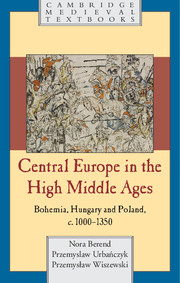Book contents
- Frontmatter
- Contents
- Note and acknowledgements
- Maps
- 1 Introduction: did Central Europe exist in the Middle Ages?
- 2 The history of the region and the question of origins
- 3 The formation of polities and Christianization
- 4 Political life and government, c. 1050–c. 1200
- 5 Society and the economy, eleventh–twelfth centuries
- 6 Ecclesiastical history, eleventh–thirteenth centuries
- 7 New developments of the thirteenth century
- Select bibliography
- Index
- References
3 - The formation of polities and Christianization
Published online by Cambridge University Press: 05 June 2014
- Frontmatter
- Contents
- Note and acknowledgements
- Maps
- 1 Introduction: did Central Europe exist in the Middle Ages?
- 2 The history of the region and the question of origins
- 3 The formation of polities and Christianization
- 4 Political life and government, c. 1050–c. 1200
- 5 Society and the economy, eleventh–twelfth centuries
- 6 Ecclesiastical history, eleventh–thirteenth centuries
- 7 New developments of the thirteenth century
- Select bibliography
- Index
- References
Summary
The tenth and eleventh centuries were a period of transition, a time when Christian polities emerged. Leaders increased their power at the expense of various rivals and Christianity penetrated the region, ultimately turning it into part of Latin Christendom. In all three areas, new polities formed under the leadership of a local elite, which became the basis of the medieval kingdoms. The reinforcement and extension of rulers’ power were intertwined with Christianization. Internal rivalries as well as relationships with neighbours – the East Frankish Kingdom (later the Ottonian Empire) in particular, but also other neighbouring territories where Christianization and the development of a polity had already started – had a significant impact on this process. Hungarians raided while Bohemians and Poles were sedentary. Nonetheless, all had contacts with Frankish/Ottonian society and were influenced by it. All three Ottonian emperors intervened frequently in political developments beyond their eastern frontier and, while they could pose a threat to their neighbours, they were also a powerful model of kingship for contemporary rulers. The dynasties of the three polities were frequently bound together by common political interests or by military conflicts. Their relations were dynamic and sometimes unpredictable, despite attempts to regulate them through pragmatic marriage strategies.
- Type
- Chapter
- Information
- Central Europe in the High Middle AgesBohemia, Hungary and Poland, c.900–c.1300, pp. 110 - 164Publisher: Cambridge University PressPrint publication year: 2013

